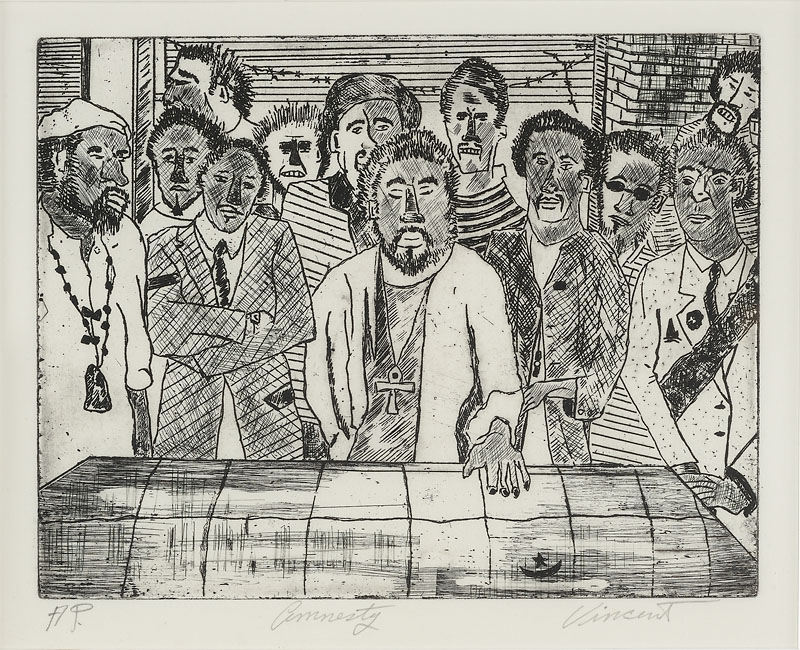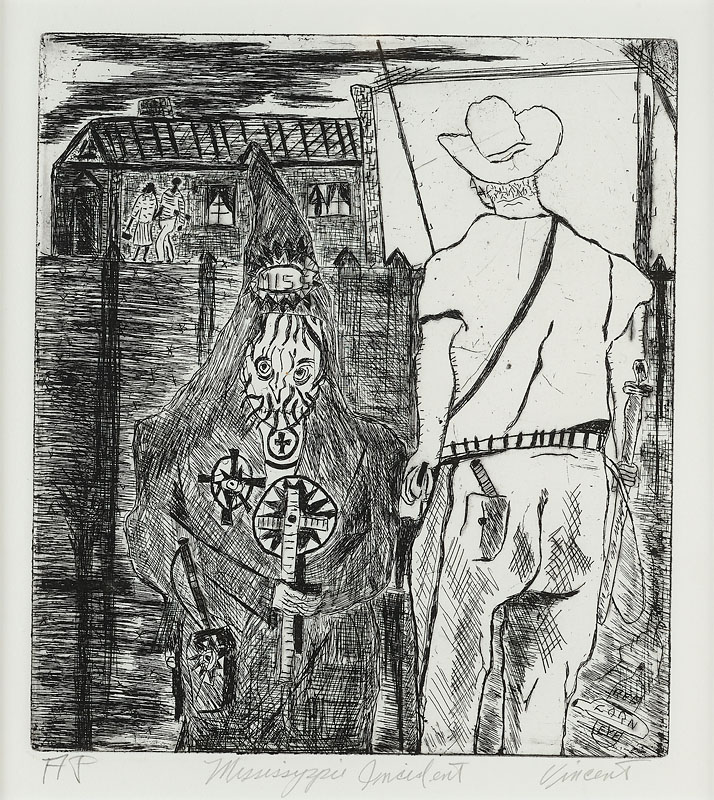Vincent Smith (1929-2004)
Mr. Smith, who had more than 25 one-man shows and participated in more than 30 group exhibitions since the early 1970's, was among about a dozen prominent members of the Black Arts movement of the 1960's and 70's. A figurative painter with an often subtle, social thrust, he placed his subjects in a stylized way against geometric, textured and intricately colored backgrounds. He stood as an expressionistic bridge between the stark figures of Jacob Lawrence and the Cubist and Abstract strains represented by black artists like Romare Bearden and Norman Lewis.
Mr. Smith, a Brooklyn native, was a high school dropout who, family members said, spent his time in school sketching in his notebooks rather than listening to his teachers. He was a railroad and postal worker, traveled the country riding the rails as a hobo and served in the Army, all before beginning to work seriously as a painter in 1953.
He eventually returned to school to earn a college degree at 50. But it was his early bitter and sweet experiences as a black man that helped shape his work, along with several visits to Africa and a series of fellowships from Maine to Maryland.
The cumulative influence of these experiences were on view in his last show, this fall at the Alexandre Gallery in Manhattan.
In his review in The New York Times, Holland Cotter noted Mr. Smith's vibrant oranges and yellows, which he said glowed ''like light through stained glass.''
''The visual effect is a little reminiscent of Rouault's expressionism, but applied to a Social Realist art inflected with references to African culture,'' Mr. Cotter wrote.
Texture also played a role in Mr. Smith's work. He often used sand and pebbles mixed with paint, said Lowery Sims, executive director of the Studio Museum in Harlem. Mr. Smith also projected a political black nationalism and cultural nationalism that came out of the 60's and 70's, she said.
In 1999 the Metropolitan Museum of Art bought the first of three of his paintings, said Gil Einstein, his art dealer.
''He said that as a boy and a young man he went to the Met and never saw paintings that looked like himself or his life,'' Mr. Einstein said. ''This was important to him because it told how far he had come as an artist and as a representative of his people.''
Coming out of his Brownsville neighborhood in the mid-40's, Mr. Smith wandered the Bowery and Greenwich Village. His wife recalled that he was drawn to Manhattan as much by its romance as by his desire to escape the gangs and violence in his neighborhood.
Mr. Smith left his postal job to paint full time in 1953. He studied from 1954 to 1956 at the Brooklyn Museum Art School and later at the Skowhegan School of Painting in Maine. He was a recipient of a John Hay Whitney Fellowship in 1959 and in the 70's received travel fellowships to study and paint in Africa and Europe.
In interviews with the artist and art historian David C. Driskell, Mr. Smith talked of how his use of color and its luminosity followed his travels. After going from the grays and blacks of Brooklyn to the vibrant greens of Skowhegan, he began landscape paintings. In Africa the sunlight's yellows and oranges struck him and became more prominent in his work. ''It just seeps in,'' he said.
He also did illustrations for a line of greeting cards and for books on jazz and the blues by his friend Amiri Baraka, the poet. Manhattan subway riders using the West 116th Street station of the No. 2 line walk past two murals he made as part of the Metropolitan Transportation Authority's Art En Route program. More of his public art commissions are at social service centers in the Bronx and Harlem and at Boys and Girls High School in the Bedford-Stuyvesant section of Brooklyn.
Partial Obituary from the NY Times. Link to full obituary:
http://www.nytimes.com/2004/01/03/arts/vincent-smith-74-painter-who-portrayed-black-life.html?mcubz=1

Amnesty
Etching
7x9 inches
Year unknown
Signed
Photo credit: John Wilson White Studio

Mississippi Incident
Etching
9x8 Inches
Signed
Photo credit: John Wilson White Studio